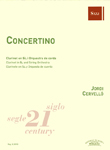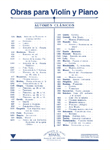Suite sobre cantos populares gallegos
Materiales de orquesta sinfónica en alquiler
Symphonyc Orchestra
GRANADOS, EnricReg.: B.3624o
- Review: MESTRE, Melani
- Ensemble: Symphonic orchestra: .
- Genres: Classical / contemporary: Symphonic.
- Product format: Partitura + particellas
- Difficulty level: Advanced-superior
- Period: Romanticism
- Publishing house: Editorial Boileau
- Collection: Siglo XXI
- No. of pages: 144
- Measure: 29,70 x 21,00 cm
- Lenght: 23'00"
- ISMN: 979-0-3503-0875-8
- Available in digital: No
- Available for rent: Yes
3[1.2.3/pic] 3[1.2.Eh] 3[1.2.3/bcl] 3 — 4 2 4 1 — tmp+2 — hp — str
perc: bd, cym, tri, glock, chimes
Strings: 7,6,5,4,3
The Suite on Galician songs was written in 1899 and debuted on 31 October that same year, as part of a series of concerts organised by the Philharmonic Society of Barcelona at the Teatro Lírico, under the direction of Joan Lamote de Grignon.
The work is made up of four movements: I. Canto de la mañana (‘Morning song’), also known as En la montaña (‘In the mountains’), II. Danza Scherzo (Galician folk dance), III. Morriña (‘Homesickness’) and IV. La Fiesta (finale). The entire composition is laced with Galician folk melodies, which serve as the pretext for developing a piece that is entirely descriptive and scenic in nature, by means of a meticulous and precise orchestration of great technical and folkloric interest. The work reveals not only Granados’ great technical expertise as orchestrator, but also his imagination and intelligence when recreating the most distinctive sounds of traditional Galician folk music. He achieves this effect through a masterful use of instrumentation and experimentation throughout the 23 minute duration of this magnificent suite.
In this suite, we can identify his knowledge and study of key orchestral works and composers representative of this scenic and descriptive aesthetic. For example, Edvard Grieg, from Norway, whose music Granados would not only champion but it would be this man who would introduce and debut his Concerto for piano and orchestra in Spain. The influences of the two French composers, Vincent d’Indy and Camille Saint-Saëns, can also be heard.
It was Granados who gave the first piano performance (accompanied by orchestra) in Spain of d’Indy’s Symphony on a French Mountain Air, a piece which is very closely related to the Suite we are discussing here, while Granados was of course a close personal friend and collaborator of Saint-Saëns, and a great ambassador of his more descriptive works. For example, Granados performed Saint-Saëns’ Fifth concerto for piano and orchestra, The Egyptian, under the baton of the composer himself, in Barcelona, in 1908. A closer reading of the Suite will reveal the influences of still more authors and works, thus confirming Granados’ enormous artistic baggage and his extensive musical knowledge, both forged following his time as a student in Paris.
This edition
Due to the interest in recovering Enric Granados’ body of orchestral works as a whole, we have seen fit to undergo a comprehensive revision of the Suite’s original manuscript, itself stored in the National Library of Catalonia under reference number A12-GRA144 and as part of the legacy bequeathed in 1982 by the composer’s youngest daughter, Natalia Granados, to the former Centre of Musical Documentation of the Generalitat of Catalonia, now known as the Granados Collection.
To mark the release of its first commercial publication, it was performed on 27 October 2010 by the Lviv Symphony Orchestra (Ukraine), under the direction of maestro Alexis Soriano. As part of the same concert, Melani Mestre, the author of this edition, also played the piano part in the world first performance of Enric Granados’ Concerto for piano and orchestra, also being published by Editorial Boileau.
For practical reasons, the decision was made to remove the fifth horn part from the final movement (La Fiesta), and to incorporate and redistribute this part among the four horns already present in the orchestral makeup since the beginning of the piece. We have found no justification for the inclusion of this additional horn. Its absence from the Suite’s three prior movements and its repetition, in many places, of the parts of the other horns, render it completely unnecessary.
In many cases, dynamics and articulation markers have been added to balance the orchestral reliefs and the symphonic narrative of the work; nuances which do not appear in the original manuscript but which serve to unify the aesthetic and audio characteristics of the string and woodwind parts. Having tested them during the various rehearsals and the later concert performance, the need to add these corrections and syntactical-musical markers to the score was confirmed, along with changes to certain notes or alterations which were either incorrect or missing. Meanwhile, it was decided to make use of and incorporate key signatures into one of the pieces, to facilitate its reading, and avoiding having to individually indicate the alterations corresponding to the notes affected.
Melani Mestre i Rebull
I. Canto de la mañana II. Danza Scherzo III. Morriña IV. La fiesta









